Macular Degeneration
Macular degeneration (MD) is a disease that causes loss of your central vision, leaving only peripheral or side vision intact. It is painless and progresses slowly making it more difficult to read, drive, see peoples faces and to see colours and contrasts. MD is currently the leading cause of blindness for people over 50 years of age in the western world. Although there are forms of macular degeneration that affect young people, it is usually related to ageing and is commonly referred to as age-related macular degeneration or AMD.
The macular is a small area at the back of the eye in the centre of the retina and is responsible for our central vision. Macular degeneration occurs when part of the retina (retinal pigment epithelium) deteriorates and is divided into two types.
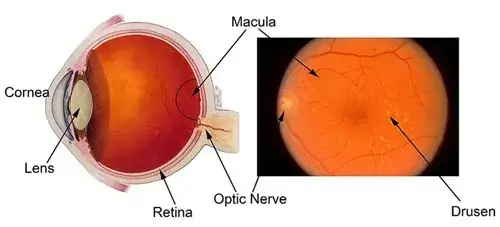
Types of Age-Related Macular Degeneration (AMD)
Dry AMD In dry AMD the cells inside the macular slowly break down resulting in a gradual loss of vision (causing patches of “missing” retina). Dry MD does not cause sudden vision loss or distortion. If you know you have dry MD and you experience any sudden change in vision, then it is likely that you have developed the “wet” form. It is critical that you see your ophthalmologist immediately. It often occurs in one eye at a time.
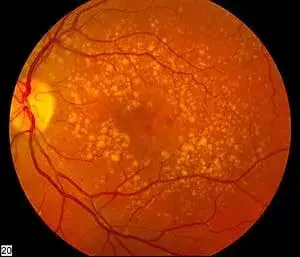
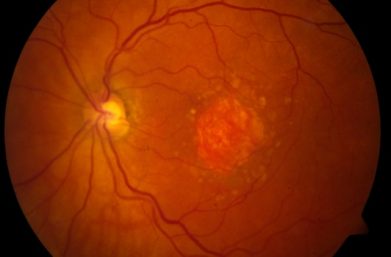
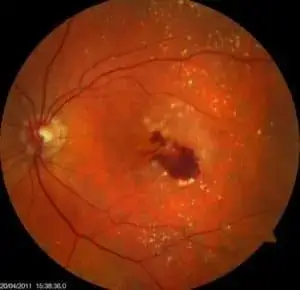 Wet AMD occurs when new blood vessels from the choroid start to grow into the retina toward the macular.
Wet AMD occurs when new blood vessels from the choroid start to grow into the retina toward the macular.
This process is called choroidal neovascularisation (CNV). Once the blood vessels invade the retina they grow very quickly but are also quite fragile and prone to leaking blood and fluid under the macular.
This can cause a loss of central vision in a short period of time. The new blood vessels are prompted to grow by a protein called Vascular Endothelial Growth Factor (VEGF).
Factors influencing the risk for developing AMD:
- Age is the most powerful risk factor
- Women tend to be at greater risk than men
- Genetic People with a history of AMD in the family are at higher risk of developing the disease
- Smoking increases the risk of AMD
- Cholesterol People with elevated levels of blood cholesterol may be at higher risk for wet AMD
Diagnosing Wet MD
If our specialist suspects Wet MD, you will be undergoing a number of tests to help determine the best course of treatment.
Fluorescein Angiogram(FFA)
This is a test which allows the blood vessels at the back of the eye to be photographed as a fluorescein dye is injected into the bloodstream via a vein in the arm and rapidly reaches the eye. The dye circulates through the retina and highlights any abnormalities or damage. This procedure takes a few minutes. The photographs taken are essential for the diagnosis and appropriate treatment planning. Fluorescein tends to turn your skin and eyes yellow for up to 24 hours until the dye is excreted through the urine.

Optical Coherence Tomography (OCT)
OCT is a non-invasive diagnostic imaging technique that uses light to produce very high-resolution cross-sectional images of the tissue layers within the retina which can be used to measure the thickness of the retina and to resolve its major layers, allowing the observation of swelling and/or leakage. It is now a standard diagnostic procedure in the diagnoses and ongoing management of Wet MD. Repeated tests are usually necessary to monitor disease activity.
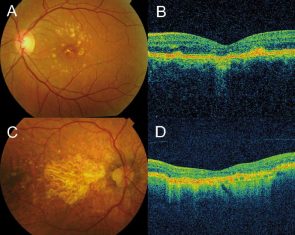
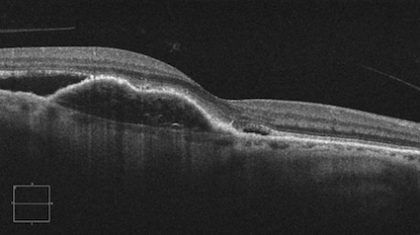
Treatment of Macular Degeneration
As with any procedure, there are risks that will be discussed with you by your surgeon.
Dry AMD – Unfortunately there are currently no treatments to reverse the effects of dry AMD. A diet rich in vitamins, minerals and antioxidants can help to slow the progression of dry AMD. Vitamins A, C and E, Zinc and beta-carotene are currently listed as being beneficial to eye health.
Wet AMD – As with dry AMD a diet rich in vitamins, minerals and antioxidants can help. The treatments for wet AMD target these new abnormal blood vessels that grow into the retina. The treatments are not curative but can be very successful with the aim of keeping the best vision for as long as possible.
There are a number of treatments (both proven and experimental) for wet AMD:
- Lucentis (Ranibizumab) or Eylea (aflibercept) – Lucentis and Eylea are anti-VEGF drugs which are injected directly into the eye cavity where it can spread to the retina to block the protein responsible for the growth of new blood vessels. The injection is generally given monthly and has been shown to effectively control Wet AMD and preserve vision in the majority of cases. Both Lucentis and Eylea are funded under the Pharmaceutical Benefits Scheme(PBS) but only for the treatment of sub-foveal (under the centre of the macula) choroidal neovascularisation due to age-related Wet Macular Degeneration.
- Photodynamic therapy – Uses a light active drug called Verteporfin (Visudyne). The drug is injected into a vein in your arm and travels up into the blood vessels in your eye. A light is shined into your eye which activates the drug and causes the blood vessel to close off. It causes minimal damage to the surrounding retina. It may take up to six months before the vision stabilizes.
- Laser photocoagulation – This procedure uses a laser to destroy and seal the leaky blood vessels. The laser not only destroys the new vessels (CNV) but also destroys the retina adjacent to the new vessel. It is becoming less commonly used and is not suitable if the disease is too advanced or if the blood vessels are growing in front of the macula. This treatment is only for a small percentage of patients with a particular type of Wet MD.

Other Treatments
- Avastin – Avastin is an anti-VEGF drug-like Lucentis which is injected into the cavity of the eye. Avastin was not initially developed to treat the eye condition. Many case reports suggest that it is safe and highly effective and has been used worldwide for treating patients with Wet MD. Avastin is used when patients are not eligible for Lucentis under the PBS (because of the location of the abnormal blood vessels) and where the cost of Lucentis or Eylea is impractical.

